
1 Teens don’t understand the big fuss. As the first generation to grow up in a wired world, they hardly know a time when computers weren’t around, and they leap at the chance to spend hours online, chatting with friends. So what?
2 But researchers nationwide are increasingly concerned that, as cyberspace replaces the pizza parlor as the local hangout, adolescents are becoming more isolated, less adept at interpersonal relationships, and perhaps numb to the small - and big - deceptions that are so much a part of the e-mail world. Researchers are asking just how the futures of teenagers are changed when so many of them are spending an hour or two on the Internet each day, replacing face-to- face contact with computer contact.
3 “We’re not only looking at what the computer can do for us, but what are they doing to us,” said sociologist Sherry Turkle. “It’s on so many people’s minds.” She wants to know how a teen’s sense of self and values may be altered in a world where personal connections and the creation of new identities can be limitless.
4 Social psychologist Robert Kraut said he’s concerned about the “opportunity costs” of so much online time for youths. He found that teens who used computers, even just a few hours a week, showed increased signs of loneliness and social isolation. In his study of 100 families that use the Internet, Kraut said these teens reported having fewer friends to hang around with, possibly because
Adapted from The Boston Globe.
their computer time replaced hours they would have spent with others. “Chatting online may be better than watching television, but it’s worse than hanging out with real friends,” he said.
5 Today’s teens, however, don’t see anything strange in the fact that the computer screen occupies a central place in their social lives. “School is stressful and busy. There’s almost no time to just hang out,” said Parker Rice, 17. “Talking online is just catch-up time.”
6 Many teens acknowledge there’s an unreal quality to their cyberspace communication, including their odd shorthand terms, such as POS (parent over shoulder) or LOL (laughing out loud). Psychologists see this code as part of the exclusive shared language that teenagers love.
7 When it comes to e-mail exchanges, teens also show a remarkable tolerance for each
other’s fudges or deceptions. Nor are they surprised when a mere acquaintance unloads a personal secret through e-mail. Nobody seems to expect the online world to be the same as the real world. Jonathon Reis, 14, didn’t seem the least bit put off when he learned that a girl wasn’t totally honest when she described herself online. “I know it’s likely they’ll say they look better than they do,” he said.
8 Teens say they also appreciate the ability to edit what they say online, or take the time to think about a response. As cowardly as it may seem, some teens admit that asking someone for a date, or breaking up, can be easier in message form. But they insist there’s no harm intended, and cyberspace has become just another medium - like the telephone - in the world of adolescence.
Predicting
Look at the picture on the opposite page. Then check (%/) the information you think you will read about in the text.
—-1- problems teens have developing interpersonal relationships
2. stories about teen violence resulting from online activities
3. opinions of teens about their online activities
4. concerns of parents about their teenage children’s computer habits
5. effects of online activities on the health of teens
Scanning
Guessing meaning from context
Restating and
making
inferences
Relating reading to personal experience
Scan the text to check your predictions. Then read the whole text.
Find the words in italics in the reading. Then match each word with its meaning.
c 1. isolated (par. 2)
2. adept (par. 2)
3. numb to (par. 2)
4. shorthand (par. 6)
5. fudge (par. 7)
6. unload (par. 7)
7. put off (par. 7)
a. written with abbreviations and symbols
b. talk about a problem
c. separated and alone
d. not concerned or bothered by
e. skillful
f. concerned or bothered
g. a dishonest statement
B
R 1. Spending a lot of time online affects teenagers’ ability to form relationships. 2. Teens who use computers to chat to spend less time with friends.
__ 3. There’s nothing wrong with teens spending hours online.
4. Every hour that teens are online is one hour less they could spend with a friend.
5. The Internet provides a way to keep in touch with friends.
6. It’s all right for people not to be completely honest when they’re online.
7. Communicating online allows more time to think about what to say.
8. Teens might be developing a different sense of what’s right and wrong.
1. How much time spent online do you think is too much? Why?
2. Do you think that everything can be communicated by e-mail? Or are some things best said face-to-face? What examples can you give?
3. Would it bother you if people lied to you online about their age or appearance?
Why or why not?
Unit 5 • Technology
39
WRAP-UP

Match each shorthand term with its meaning. Be careful! There are two extra answers. (Answers appear below.)
l.LOL | a. be seeing you |
2. cm | b. call me |
3. cul8r | c. end of discussion |
4. h2cus | d. gotta go |
5. idk | e. hope to see you soon |
6. wot | f. I don’t know |
7. j4f | g. I’ll look into it |
8 -g2g | h. just for fun |
9.ppl | i. laughing out loud |
10. eod | j. people k. see you later l. what |
B
1. POS parent over shoulder _
2. wan2 _ _
3. b4
4. ruok
5. 2moro
6. gr8
7. bf / gf
8. 2dA
Think of five other shorthand terms you could use to chat with someone online. Then ask your classmates to guess what they mean.
Aupo} 'g puaujpiS/puaujXoq - i j'EajS 9 Avojjouio} '5 }jo noX are -p ajojaq •£ oj jubm japjnoqs jbao juared -g 3 01 f'6 P'8 H'Z I'9 J'S VZ ! I V^HaAVSMV
Unit 5 • Technology


You are going to read three texts about punishment. First, answer the questions in the boxes.
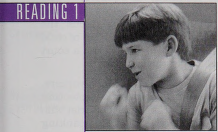
READING 2

This magazine article reports on an American who was arrested in Canada for spanking his daughter.
1. Is spanking a common punishment in your country?
2. Have you ever seen a parent strike his or her child?
3. What kinds of laws should protect children from parental punishment? Why?
In this excerpt from a novel, a girl gets into trouble with her mother for receiving a letter.
1. Have you ever angered your parents? If so, how?
2. Have your parents ever disapproved of your friends? If so, why?
3. Have your parents ever made you do something you didn't want to do? If so, what?
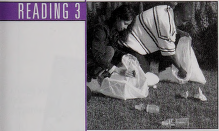
This newspaper article describes how suspension is changing in some California schools.
1. Do schools in your country suspend students?
2. In your country, is cleaning the school a duty or a punishment?
3. How do you think parents feel when their child is suspended from school?
Find out the meanings of the words in italics. Then answer the questions.
1. Did you often act up when you were a child?
2. What kind of punishment should parents inflict on their children?
3. If you were a teacher, what would you do if your students were insolent ?
4. What should be done about students who have a bad attitude ?
5. How important is it for teachers to use discipline in the classroom?
6. Should schools penalize students who are caught wrestling in the hallway?
Unit 6 • Punishment


1 It was his wife’s birthday and David Peterson had taken a break from the drive home to celebrate at a restaurant in London, Ontario. With him was his whole family - wife Paula, five-year-old daughter Rachel, and son William, two - fresh from a vacation in Niagara Falls. But Rachel was acting up, refusing to stop wrestling with her brother. When Peterson and his kids went back to the car to fetch a present for their mother, Rachel went over the line. She pushed her brother out of the car to the parking lot asphalt, then slammed the door on his fingers when he tried to get back in. Angered, Peterson did what parents have done with insolent children for centuries: He spanked her. But Marlene Timperio, a mother of a six-year-old boy, saw it all. Noting the Illinois license plate on Peterson’s vehicle, Timperio confronted the American, telling him: “This is not what we do in Canada.” And then she called the police.
2 So began David Peterson’s ordeal, which included a night in a London jail and months of legal headaches, culminating in his trial and acquittal last week on charges of assault. “We were just passing through,” the 39-year-old told reporters after the verdict in London, “and we stepped in it, so to speak.”
3 Indeed. There are few more contentious issues in parenting - to spank or not to spank? And the Peterson case has only added fuel to the long-standing debate. At the heart of the debate is Section 43 of the Canadian Criminal Code. It allows parents, teachers, and guardians to use “force by way of correction toward a pupil or child ... if the force does not exceed what is reasonable under the circumstance.” During last week’s trial, Peterson’s lawyer, Michael Menear, argued that the section protected parents who “honestly believe” they are teaching their children proper behavior and do not inflict injury in the process.
4 In his ruling, Mr. Justice John Menzies of the Ontario Court’s Provincial Division said he was convinced the Petersons were “responsible, reasonable, and caring parents,” and that the spanking of Rachel was not excessive. Menzies added that the testimony of Timperio - who acknowledged that she opposes physical discipline - “brings into sharp focus the different views in society on the subject of child discipline.” Still, he added, “this is not a court of social justice, but of the law.”
5 But to many child experts and family workers, that law does not go far enough in protecting children. Dr. Elliott Barker, a psychiatrist who treats violent offenders, says that spanking can have “enormous costs” for both individuals and society. “To have the person you are most dependent on turn on you is a psychological blow you don’t forget,” says Barker. Children, he adds, will come to “believe that spanking is good, and they go on and spank their own kids.”
6 After the trial last week, Paula Peterson declined to say whether she and her husband will continue to spank their children. “That’s a decision my husband and I will make,” she said. Both parents said that they had no hard feelings about Canadians, nor about the debate that has raged around that day in the parking lot.
Adapted from Maclean's.
Check (✓) the information you think you will read about in the text.
1. the behavior of the child who was spanked
2. the name of the person who called the police _ 3. the law the parent was accused of breaking
4. the reasons why parents shouldn’t spank _ 5. the names of experts who support spanking
Scan the text to check your predictions. Then read the whole text.
A
Check (»/) the correct statement.
1. The writer supports spanking.
2. The writer opposes spanking.
3. The writer doesn’t express an opinion.
B
b 1. ordeal (par. 2)
2. culminating (par. 2)
3. acquittal (par. 2)
4. contentious (par. 3)
5. turn on (par. 5)
6. blow (par. 5)
7. declined (par. 6)
a. freedom from criminal charges
b. a difficult experience
c. refused
d. attack suddenly
e. a sudden shock with damaging effects
f. ending
g. causing disagreement

a. the judge’s decision
b. the problems with laws that protect children
1_ c. the story that caused the trial
d. the main argument in the Peterson trial
e. the Peterson’s feelings about what happened
f. the problems the Petersons had as a result of the spanking

Answer these questions.
1. Do you think it is acceptable to spank a child? Why or why not?
2. Do you think Marlene Timperio was right or wrong to call the police? Why?
3. What is the most effective way for parents to punish two-year-olds? Six-year- olds? Nine-year-olds? Thirteen-year-olds? Seventeen-year-olds?


1 Her mother read the letter standing in the middle of the hut with one hand on her forehead. While she read her lips moved rapidly, her eyes blinked severely and often. Finished, she sat down on the edge of a chair, dangled the letter in her hand for a moment, then sighed and took off her glasses. “Surely not,” she said in Japanese.
2 She set the glasses in her lap wearily, placed the letter on top of them, and pressed against her eyes with both palms.
3 “The neighborhood boy,” she said aloud. “The one who taught her how to swim.”
4 Now she stood with this letter in her hand - a letter a boy had sent to her daughter about love. The depth of her deceit became vivid to Fujiko, and she felt in herself a mother’s rage at the weight of this betrayal.
5 She reminded herself to behave with dignity no matter what the circumstances, a worthy lesson passed down from her grandmother. Giri was her grandmother’s word for it — it could not be precisely translated into English — and it meant doing what one had to do quietly and with an entirely stoic demeanor. Fujiko sat back and cultivated in herself the spirit of quiet dignity that would be necessary in confronting Hatsue. She breathed deeply and shut her eyes.
6 Well, she told herself, she would have a talk with Hatsue when the girl came back from wandering aimlessly around the camp. She would put an end to this business.
7 At this moment Hatsue came through the door, her face reddened by the cold outside, and tugged the scarf from her head. When the door had shut Fujiko reached behind her and handed Hatsue the letter. “Here,” she spat. “Your mail. I don’t know how you could have been so deceitful. I'll never understand it, Hatsue.”
8 She had planned to discuss the matter right there and then, but she understood suddenly that the strength of her bitterness might prevent her from saying what she really meant. “You will not write again to this boy or accept his letters,” she said sternly from the doorway.
9 The girl sat with the letter in her hand, tears gathering in her eyes. “I’m sorry,” Hatsue said. “Forgive me, Mother. I’ve deceived you and I’ve always known it.”
10 “Deceiving me,” said Fujiko in Japanese, “is only half of it, daughter. You have deceived yourself, too.”
11 Then Fujiko went out into the wind. She walked to the post office and told the clerk there to hold all mail for the Imada family. From now on, she herself would come for it. It should be handed to her only.
That afternoon she sat and wrote her own letter addressed to the boy’s parents. She showed it to Hatsue when it was folded and ready to go into its envelope, then took it from her daughter’s lap and ripped it neatly down the middle. “Write your own letter,” she said in Japanese. “Tell him the truth, about things. Put all of this in your history. Tell him the truth so you can move forward. Put this boy away now.”
13 In the morning Fujiko took Hatsue’s letter to the post office and paid the postage on it. She licked the envelope shut herself and, because the notion took hold of her suddenly - a kind of caprice and nothing more — she pressed the stamp on upside down before putting the letter in the mailbox.
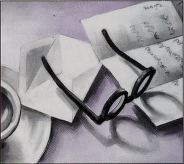
Somet
nronorloc tho
Adapted from Snow Falling On Cedars.
Sometimes the meaning of a word precedes the word. For example, in paragraph 13, the meaning of caprice is a notion [that] took hold of her suddenly.
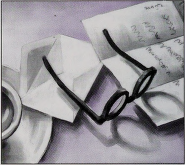
Look at the picture on the opposite page and these phrases from the text. What do you think happens in the story?
“The neighborhood boy” behave with dignity “Forgive me.”
this betrayal put an end to this business “Write your own letter.”
a mothers rage I ve deceived you.” letter in the mailbox
Scan the text to check your prediction. Then read the whole text.

What is the tone of the text? Check
1. humorous
2. serious -
(%/) the correct answer.
3. cheerful
4. sarcastic

Who does
H 1 . 2 .
3.
4.
5.
6 .
-7.
8 .
She received a letter from a boy.
She read the letter the boy wrote.
She was angry.
She was apologetic.
She wrote a letter to the boy’s family.
She wrote a letter to the boy.
She tore up the letter.
She mailed the letter.

Answer the questions.
1. How old do you think Hatsue is?
2. What time of year do you think it is?
3. What do you think the boy wrote in his letter?
4. What do you think Fujiko’s character is like?
5. What do you think Hatsue’s character is like?

Answer these questions.
1. Do you think Fujiko was right to forbid her daughter from communicating with the boy? Why or why not?
2. What do you think Hatsue wrote in her letter?
3. Do fathers and mothers differ in the way they punish children? If so, how?
1 Suspension just isn’t what it used to be. Once, frustrated school officials could be sure that if they kicked a misbehaving student out of school, the student’s angry and embarrassed parents would do the rest in terms of punishment.
2 But these days, too many parents are working, while others couldn’t care less, to be effective jailers. For some students, suspension has become another holiday, all the sweeter because everyone else is in class.
3 Now, several principals in Ventura County are having second thoughts about the whole concept of suspension. They are revamping discipline policies and endorsing a revolutionary approach to punishment - instead of sending students home to the living room couch and daytime TV, they are keeping more troublemakers at school. Students who break school rules are still suspended, but are exiled on campus, where they catch up on homework, write personal goals, or clean up the school.
4 “It’s not as fun to be at school as it is to be at home,” said Ventura County official Miles Weiss. “And if you are a delinquent or you misbehave at school, you should suffer a consequence, not a reward.”
5 Administrators are also concerned about teens falling behind in school. “We want to keep students in school because that’s our business,” said principal Bob La Belle. “We don’t want the students to fall further behind, and penalize them unfairly for what may have happened in one period.” He said
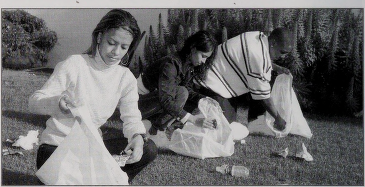
on-campus suspension prevents the “snowball effect,” when a student who gets in trouble in one class is sent home for a few days and ends up behind in all six classes.
6 In several schools, teachers or campus supervisors watch over suspended students. Some schools call their on-campus suspension classes “opportunity rooms.” Educators say it’s a good name, underscoring the idea that these are places where students have the opportunity to turn their lives around. “Behavior is an outward sign of an inner problem in school,” said school superintendent Chuck Weis. “Suspension can give us an opportunity to work on that real underlying problem.”
7 Middle school students from Ventura are sent to a special “suspension school” held on Fridays at Ventura College. They spend from 8 a.m. to 2 p.m. there, involved in activities aimed at controlling their anger, boosting their self-esteem, and improving their attitude toward school. In return, the suspension doesn’t show up on their school record.
8 At 8:15 a.m. on a recent Friday, teacher Peter Shedlosky asked the students to introduce themselves: their names, grades, schools, and reason for suspension. A few kids’ voices cracked as they took their turns reciting their transgressions: “I got kicked out of class. I pushed this guy. I beat up some kid. I got in a fight.”
9 Ventura educators say having the suspension school on a college campus also motivates the students to improve their behavior and grades. During the day, they take a tour of the college campus, look through the college catalog, and talk about careers.
10 Westlake High School’s on- campus suspension program serves both students and staff. After spending all morning in various study hall classrooms, the students are handed trash bags and ordered to work. As they traverse the hillside and the parking lot picking up coffee cups, soda cans, and fast-food bags, a few classmates pass by, pointing and laughing at the trash collectors.
Adapted from The Los Angeles Times.
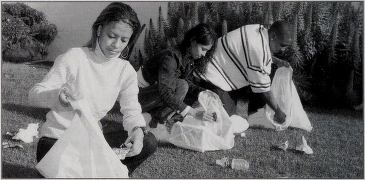
Relating to the topic
Scanning
Recognizing
purpose
Guessing meaning from context
Relating reading to personal experience
B
Check (*/) the statements you agree with.
1. Parents should punish children who get in trouble at school.
2. Schools should punish students who misbehave.
3. Students who behave badly should be suspended from school.
4. Students who behave badly should do extra work at school.
5. Students who break rules should spend their suspension at home.
Scan the text to find out which statements Ventura educators agree with.
Then read the whole text.
Check (^) the writer's main purpose in writing the text.
1. to convince parents to support school officials’ decisions
2. to describe the benefits of on-campus suspension programs
3. to inform educators of some modern punishment techniques
c 1. revamping (par. 3)
2. endorsing (par. 3)
3. exiled (par. 3)
4. delinquent (par. 4)
5. underscoring (par. 6)
6. transgressions (par. 8)
7. traverse (par. 10)
a. separated from others
b. move across
c. changing and improving
d. emphasizing
e. a person who behaves badly
f. supporting
g. actions that break rules
1. Who should punish a student who gets into trouble at school, the student’s parents or school officials? Why?
2. What kinds of misbehavior should a student be punished for? What kinds of behaviors should teachers ignore?
3. Which on-campus suspension activity do you think is most effective? Why?
a. cleaning up the school
b. spending all morning in study hall
c. becoming familiar with a college campus
d. talking about careers
e. learning to control anger and boost self-esteem
f. writing personal goals

WRAP-UP

Adjective | Noun | Verb |
1. confrontational | confrontation | |
2. | deceit | |
3. | discipline | |
4. effective | ||
5. | exceed | |
6. | penalize | |
7. | punishment | punish |
8. | suspension |
B
1. Driving without a license is a punishable offense.
adj.
2. If we you from school, you won’t be able to return for one week.
3. Many people think there should be a stronger for cheating on exams.
4. Students who don’t go to school will face action.
5. He tried to the police by saying he didn’t own the car he was driving.
6. Drivers who
7. The criminal was
8. We are going to study the
the speed limit near a school have to pay a large fine, by an angry crowd.
of our policy to see how well it works.
Work in groups. Number the offenses from 1 (least serious) to 8 (most serious). Then think of a suitable punishment for each one.
arson 1 cheating in school littering 3 shoplifting 4
bank robbery_euthanasia 2 _ lying speeding
1 setting a fire in order to damage or destroy something, especially a building
2 killing someone who is very ill to end his or her suffering
3 throwing out pieces of paper and other small objects in public places
4 taking things from a store without paying for them
48

PREVIEW

You are going to read three texts about loss. First, answer the questions in the boxes.
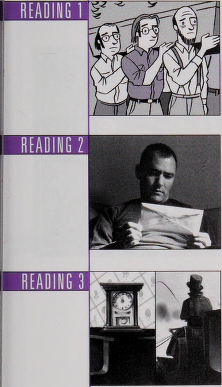
Vocabulary
Read from this website to find out how traditions in one part of the world mark the passing of a loved one.
1. What colors do people in mourning usually wear in your country?
2. What do people in your culture believe happens to the soul after death?
3. What do widows do after their husbands die? What about widowers?
What do people do to remember someone who dies? This scene from a play shows how one man deals with the loss of his wife.
1. What can a person do to forget the loss of a spouse?
2. Should someone who has lost a spouse move to a new home?
3. Is it appropriate for someone in mourning to laugh and try to forget?
Two renowned poets write about the end of life.
1. How do people usually react to the loss of a loved one?
2. In your culture, is death viewed as a beginning or an ending?
3. What are common symbols of death in your culture?
Find out the meanings of the words in italics. Then check (%/) the statements that are true about your country.
1. People send condolence cards or letters.
2. There are funeral processions.
3. Hearses are used to transport coffins.
4. People honor the memory of their late parents.
5. It is acceptable for people to grieve in public.
6. There are special days when people visit the graves of family members.
Unit 7 • Loss


READING 1
1 A solemn funeral procession slowly winds its way deep into the hills of Kentucky. Six men carry a homemade coffin on their shoulders. Behind is a grieving widow and children, followed by friends and family. There are no sleek, black hearses here, no somber men in dark suits. But this is how folks in Appalachia have buried their dead for hundreds of years. Bearing the coffin to the family cemetery is the last act in a string of traditions.
2 Traditions in Appalachia and the American South are sometimes bound in superstition. The moment that a person dies, a whole series of customs begins to speed the departed's trip to the hereafter, and to insure the well-being of those left behind. A century ago, these rituals were commonplace. Today, however, they are practiced in only some areas.

3 Take, for instance, beliefs about what happens to the soul. Some people believed that the soul remained with the body 24 hours after death. Members of the family, or friends of the deceased, often chose to "sit up" with the body to keep the soul company.
4 While the body was still in the house, certain precautions were taken to insure the welfare of the living. For example, the body was always laid out on the first floor of the house, never on an upper floor. If a step squeaked while the body was still under the roof, there would be a death in the family within a year. Likewise, all clocks were stopped immediately after a death. If a clock stopped on its own, another death would occur shortly.
5 The time of day a person died dictated when the grave was dug. If a person died at night or early in the morning, for example, the grave was dug after noon on the following day. It was bad luck to leave a freshly excavated grave open all night.
6 Digging the grave was a solemn task reserved for family and friends. They dug the grave and filled it up after the funeral. Graves always faced the east toward the rising sun, the symbol of resurrection.
7 After the burial of her husband, the grieving widow was expected to enter a period of mourning. The traditional mourning garb, of course, was black. She gave away all her colored clothing because that was considered good luck.
8 The widow also faced another set of restrictions. She could not court again until a year after the death of her husband, and could not marry for two years after that. The widow was required to visit the grave of her late husband at least four times a week during mourning. She could not speak to another man, unless it was a member of her family or the preacher, until the grave was filled. She could not sing any song, unless it was a hymn, and she could not participate in any kind of recreation. She was forbidden to eat cake, pie, or candy. Nor was she allowed to sip any sweet drink except coffee.
9 If a widow mourned for more than one year, it was bad luck. With restrictions like that hanging over her head, I would dare say that one year of serious lament was more than sufficient.
Adapted from www.va.essortment.com/deathsuperstiti_rxzf.htm.
VVW
Using previous knowledge
Look at the picture on the opposite page. Where do you think it was taken?
Skimming
Skim the text to check your answer. Then read the whole text.
Recognizing similarity in meaning
Understanding
details
Match each word or phrase with a word | or phrase that is similar in |
— <L_ 1. somber (par. 1) | a. carry (par. 1) |
2. bearing (par. 1) | b. mourning (pars. 7, 8) |
3. string (par. 1) | c. deceased (par. 3) |
4. customs (par. 2) | d. solemn (pars. 1, 6) |
5. departed (par. 2) | e. traditions (par. 2) |
6. welfare (par. 4) | f. series (par. 2) |
7. under the roof (par. 4) | g. well-being (par. 2) |
8. excavated (par. 5) | h. in the house (par. 4) |
9. garb (par. 7) | i. dug (par. 5) |
10. lament (par. 9) | j. clothing (par. 7) |
B
Relating reading to personal experience

Good luck | Bad Luck | |
1. People leave the body alone during the first 24 hours after death. | / | |
2. People go upstairs while the body is still in the house. | ||
3. A clock stops working in the house where the body is. | ||
4. The grave faces the direction of the rising sun. | ||
5. People dig a grave in the afternoon for a funeral the next day. | ||
6. A widow gives away all her clothing that is not black. | j | |
7. A widow mourns for three years. | 1 |
Table captionAnswer these questions.
1. What superstitions are associated with death in your country?
2. Do death rituals vary in different parts of your country? If so, what examples can you give?
3. If foreign visitors asked about your country’s rituals after someone dies, what would you say?
Unit 7 • Loss

READING 2


Marvin Neil Simon (1927—) Born in the Bronx, New York, Neil Simon quickly established himself as
America’s most successful playwright. Following the death of his wife in 1973, Simon went on to write
Chapter Two, which was considered by many critics to be his finest play to that date.
1 Leo . . . What are you reading?
George My mail.
LEO Anything interesting?
GEORGE Not unless you like letters of condolence. I thought I answered my last one when I left. You want to listen to something, Leo?
Leo George, you just got home. You’re tired. Why don’t you defrost the bathroom, take a bath?
GEORGE Just one letter: “Dear Mr. Schneider, My name is
10 Mary Ann Patterson. We’ve never met, but I did
know your late wife, Barbara, casually. I work at Sabrina’s, where she used to come to have her hair cut. She was so beautiful and one of the warmest people I’ve ever met. It seems I always used to tell her my troubles, and she always found some terrific thing to say to cheer me up. I will miss her smiling face and the way she used to come bouncing into the shop like a little girl. I feel lucky to have known her. I just wanted to return a little of her good cheer. God bless you and keep you. Mary Ann Patterson." (He puts down the letter. Leo looks at him, knouHng not to intrude on this moment.) What the hell did I read that for?
20 Leo It’s very nice. It’s a sweet letter, George.
GEORGE Barbara knew a whole world of people I never knew . . . She knew that Ricco, the mailman, was a birdwatcher in Central Park, and that Vince, the butcher in Gristede’s, painted miniature portraits of cats every weekend in his basement on Staten Island . . . She talked to people all year long that I said hello to on Christmas.
LEO I think you could have used another month in Europe.
GEORGE You mean, I was supposed to come home and forget I had a wife for twelve years?
It doesn't work that way, Leo. It was, perhaps, the dumbest trip I ever took in my whole life. London was bankrupt, Italy was on strike, France hated me . . . Why do Americans go to grief- stricken Europe when they’re trying to get over being stricken with grief?
30 Leo Beats me. I always thought you could have just as rotten a time here in America.
GEORGE What am I going to do about this apartment, Leo?
LEO My advice? Move. Find a new place for yourself.
GEORGE It was very spooky in London ... I kept walking around the streets looking for Barbara - Harrod’s King’s Road, Portobello . . . Sales clerks would say, “See what you want, sir?” and I’d say, “No, she’s not here.’ I know it’s crazy, Leo, but I really thought to myself, It’s a joke. She’s not dead. She’s in London waiting for me. She’s just playing out this romantic fantasy: The whole world thinks she’s gone, but we meet clandestinely in London, move into a flat, disappear from everyone and live out our lives in secret! . . . She would have thought of something like that, you know.
40 LEO But she didn’t. You did.
GEORGE In Rome I got sore at her — I mean really mad. How dare she do a thing like this to me? I would never do a thing like that to her. Never! Like a nut, walking up the Via Veneto one night, cursing my dead wife.
LEO In Italy, they probably didn’t pay attention.
GEORGE In Italy, they agree with you. (He shrugs) Okay, Leo, my sweet baby brother, I’m back . . . Chapter Two in the life of George Schneider. Where the hell do I begin?
From Chapter Two.

Read the backround information about this scene. Then answer the questions below.
After the death of his wife, George Schneider, 42, spent a month in Europe. He has just returned home. His brother, Leo, has picked him up at the airport, and they have just entered the apartment George shared with his late wife. The first thing George does is look through the mail.
1. What do you think George did on his trip to Europe?
2. What do you think he finds in the mail?
Scan the text to check your predictions. Then read the whole text.

Find the words in italics in the reading. Circle the meaning of each word.
1. stricken (line 26)
a. (suffering greatly)
b. knowing about
c. refusing to work
2. rotten (line 27)
a. enjoyable
b. interesting
c. terrible
3. spooky (line 31)
a. expensive
b. frightening
c. boring
4. clandestinely (line 35)
a. slowly
b. patiently
c. secretly
5. nut (line 40)
a. a kind person
b. a strange person
c. a ghost
6. cursing (line 41)
a. wishing things were different
b. saying bad words at
c. talking to oneself
B
/ 1. George got letters of condolence before he went on his trip.
2. Leo thinks George should do things to forget his wife’s death. _ 3. Leo didn’t like George’s wife.
4. Barbara was friendlier than George.
5. George loved his wife very much.
6. George didn’t miss his wife until he returned home.
7. George is excited about the changes in his life.

Answer these questions.
1. Why do you think the play is called Chapter Two ?
2. What do you think George does next?
3. What advice would you give George?
53


Wystan Hugh Auden (1907—1973) Generally considered one of the most important poets of the twentieth century, the English-horn writer has had a major literary influence on both sides of the Atlantic. The 1930 publication of his collection Poems established him as the leading voice of a new generation.
1 Stop all the clocks, cut off the telephones,
Prevent the dog from barking with a juicy bone,
Silence the pianos and with muffled drum Bring out the coffin, let the mourners come.
2 Let aeroplanes circle moaning overhead Scribbling on the sky the message He Is Dead,
Put crepe bows round the white necks of the public doves,
Let the traffic policemen wear black cotton gloves.
3 He was my North, my South, my East and West,
My working week and my Sunday rest,
My moon, my midnight, my talk, my song;
I thought that love would last for ever: I was wrong.
4 The stars are not wanted now: put out every one;
Pack up the moon and dismantle the sun;
Pour away the ocean and sweep up the wood;
For nothing now can ever come to any good.
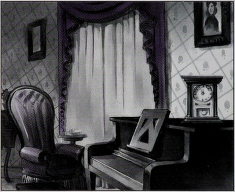
Emily Dickinson (1830—1886) America’s best-known female poet, Emily Dickinson is one of the most innovative writers in nineteenth-century American literature. Her use of metaphors to deal with issues of death, faith, immortality, and nature significantly influenced modern poetr) 1 .
1 Because I could not stop for Death,
He kindly stopped for me;
The carriage held but just ourselves And Immortality.
We slowly drove, he knew no haste,
And I had put away My labor, and my leisure too,
For his civility.
We passed the school where children played, Their lessons scarcely done;
We passed the fields of gazing grain,
We passed the setting sun.
4 We paused before a house that seemed A swelling of the ground;
The roof was scarcely visible,
The cornice but a mound.
Since then tis centuries; but each Feels shorter than the day I first surmised the horses’ heads Were toward eternity.
Each line of English poetry usually begins with
a capital letter. For example, in verse 2, line 8 of "The Chariot," For is capitalized because it is at the beginning of the line, not because it begins a new sentence.

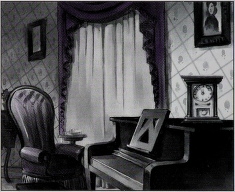
Predicting
Look at the titles of the poems and the pictures on the opposite page. Predict what each poem is about. (Note: Blues is a slow, sad type of music or a mood of sadness. A chariot is a two-wheeled vehicle pulled by a horse.)
Skimming
Skim the text to check your predictions. Then read the whole text.
Guessing meaning from context

Find the words in the reading that match each definition.
1. _ muffled _: made quieter and less clear (“Funeral Blues,” verse 1)
2. --: making a long low sound of pain (“Funeral Blues,” verse 2)
3. __: birds (“Funeral Blues,” verse 2)
4. _: the state of living forever (“The Chariot,” verse 1)
5. _great speed (“The Chariot,” verse 2)
6. _: polite behavior (“The Chariot,” verse 2)
7. _: decoration at the top of a building (“The Chariot,” verse 4)
8. _: guessed (“The Chariot,” verse 5)
Understanding main ideas

Circle the correct answers.
1. Who died in “Funeral Blues”?
a. someone famous
b. someone the poet loved
2. What is the poet’s reaction to the death?
a. Life isn’t worth living.
b. Life will go on.
3. What is “The Chariot” about?
a. the fear of death
b. the peacefulness of death
4. What does the chariot represent?
a. Death taking the narrator into eternity
b. the narrator’s memories of life
5. What is the main idea of “The Chariot”?
a. Death is nothing to be afraid of.
b. We must remember those who leave.
Rhyming

1. telephone bone 5. West
2. drum _ 6. song
3. overhead_ 7. one
4. doves _ 8. wood
9. me
10. done
11. ground _
12. day
Relating reading to personal experience

Answer these questions.
1. Which poem do you prefer? Why?
2. How long do you think the first poet grieved? Why?
3. Do you agree with the second poet that death should not be feared? Why or why not?
55
Unit 7 • Loss

WRAP-UP
Homographs are words that have the same spelling but different meanings. They also may have different pronunciations. Circle the homographs in the pairs of sentences below. Then choose the correct meaning of each circled word from below.
/
1. The ( winds) are strong today.
2. The road winds through the valley.
3. The dove is a symbol of peace.
4. The swimmer dove into the water.
5. They say that cats have nine lives.
6. Kate lives in London.
7. The gifts have large bows on them.
8. Taro bows when he greets people.
9. The sad child wept tears.
10. This material tears easily.
11. Men will lead the funeral possession. -12. Pencils contain lead.
a. pulls into pieces
b. jumped headfirst into water
c. a black material used for writing
d. moves in a curving manner
e. decorative knots
f. periods between birth and death
g. walk in front, with others following
h. bends forward to show respect
i. makes one’s home somewhere
j. drops of liquid that flow from the eye
k. a type of white bird
l. movements of the air outside

1. In 1,
2. In 2,
3. In 3,
4. In 4,
5. In 5,
6. In 6,
winds rhymes with minds / ( twins) winds rhymes with minds / twins.
dove rhymes with love / stove. dove rhymes with love / stove.
lives rhymes with fives / gives. lives rhymes with fives / gives.
7. In 7, bows rhymes with knows / cows.
8. In 8, bows rhymes with knows / cows.
9. In 9, tears rhymes with fears / wears.
10. In 10, tears rhymes with fears / wears.
11. In 11, lead rhymes with need / red.
12. In 12, lead rhymes with need / red.
Look at Reading 2 on page 52 again. Imagine you went to high school or college with George’s late wife. Write George a letter of condolence. Include memories about her in your letter.
56
Unit 7 • Loss

PREVIEW

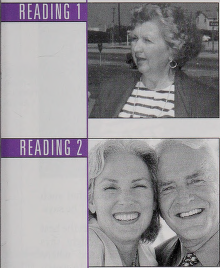
Read this newspaper article to discover whether your memory is as accurate as you think it is.
1. Can police trust eyewitness's reports?
2. Have you ever witnessed an accident? Do you remember the details?
3. Do you know anyone who can remember everything?
This newspaper article describes how complete memory loss affected one man and those around him.
1. What causes memory loss?
2. What do you think a woman would do if her husband didn't remember her?
3. How would you feel if you suddenly couldn't remember anything?

What can you do to improve your memory? Read this newspaper article for some answers.
1. What do you do to help you remember things?
2. What is easy for you to remember? What is difficult?
3. Do you think students who have a good memory do better in school?
Find out the meanings of the words in italics. Then check (✓) the statements that are true about you.
1. I know someone whose memory has diminished with age.
2. I occasionally have a memory lapse.
3. It’s hard to remember things when I have a lot on my mind.
4. I can recall some things better than others.
5. I retain information better if I learn it earlier in the day.
6. I can retrieve memories from certain periods of my life better than others.
87
Unit 8 • Memory



1 A crime’s been committed. The police are sure they have the right guy in custody. After all, they have an eyewitness. But should they be so sure? “No,” claim psychologists who have studied eyewitness testimony.
2 Daniel Wright, a psychologist at Sussex University, has found that when witnesses are given misleading information after an incident, some will adapt their memories to accommodate this new information. In one experiment, 40 students looked at a picture book showing the story of two men meeting at a pool hall and of a woman later stealing one man’s wallet. Each student studied the book on his or her own.
3 Without any of the volunteers knowing, half of the group had slightly different information from the other half. Twenty students saw a picture book showing the woman loitering outside the pool hall on her own before the crime. The other half saw a picture of her loitering with an accomplice.
4 When questioned afterwards, on their own, about whether the woman had an accomplice, 39 of the 40 students got it right. Then the students were paired off so that, in each pair, only one had seen the picture book featuring the accomplice and one had viewed the picture book without the accomplice.
5 Each pair was asked to discuss what they knew, and to answer the question jointly: Did the woman have an accomplice?
6 Since the members of each pair had seen different scenarios, none of them should have reached agreement. In fact, fifteen pairs reached a compromise. In other
words, 15 witnesses were swayed by what their partner had told them. (Eight pairs reported no accomplice, while seven reported the opposite).
7 One reason why our memories change is that, when given information, we use it to fill visual gaps. Wright explains: “Imagine a police officer saying, ‘I want to ask you about the collision between the red car and green car. Was there a Yield sign at the junction?’ If you can’t remember the colors, you may use this information to fill the gaps and you may later remember the cars being red and green.”
8 False memories can even be planted from scratch. Give people a selection of childhood memories, three of which are true and one is false (the experimenters collaborate with parents), and many subjects will come to believe, quite strongly, that all were genuine experiences. “You can convince adult volunteers that they were lost in a shopping mall as a child even
though parents confirm that such an event never took place,” he says.
9 So how can the police get the best out of eyewitnesses? Wright says that the best cases are where observers have been able to watch a culprit for a while rather than seeing them for a fleeting moment. All interviews should be conducted as soon as possible, with witnesses freely recalling what happened and not subjected to leading questions.
10 “If you give memory too much of a helping hand, memories will appear, whether they are true or not,” Wright says.
Adapted from The Times (London).
Thinking about
personal
experience
Check (✓) the statements you think are true.
1. Witnesses sometimes change their stories when they hear new information.
2. Adults can be convinced that invented events happened to them as children.
3. Witnesses memories are affected by how long they observe something.
4. It doesn’t matter how long after a crime an eyewitness is interviewed.
Scanning
Scan the text to check your answers. Then read the whole text.
Distinguishing main and supporting ideas

Identify which sentence in each pair is the main idea and which is the supporting idea. Write main idea ( M) or supporting idea (S).
1. Ad a. Witnesses adapt their memories to include new information.
$ b. Psychologists have studied eyewitness testimony.
2. a. If a police officer mentions red and green cars, you may remember them, b. We use new information to fill visual gaps.
3. a. You can convince adults of childhood events that never occurred, b. False memories can be created from scratch.
Understanding
details

1. Number of people in the experiment: 40
2. Number correct in part one of the experiment:
3. Task of pairs in part two of the experiment:
4. Reason pairs should not reach an agreement:
5. Number of pairs reporting an accomplice:
6. Number of pairs reporting no accomplice:
7. Findings of the experiment:
Relating reading to personal experience

Answer these questions.
1. What should the police do when the only proof is eyewitness testimony? Why?
2. Do you remember things that happened to you as a child? Would other family members agree with your memory of the event?
3. What happened the first time this class met? Do your classmates agree?
59

